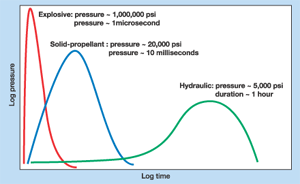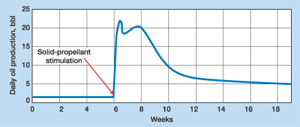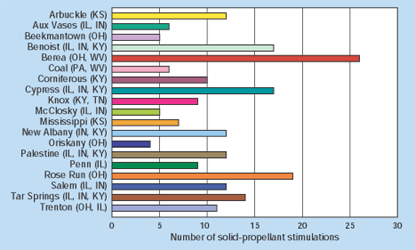Solid propellants provide cost-effective stimulation in marginal wells
Solid propellants provide cost-effective stimulation in marginal wellsDr. Richard A. Schmidt, J Integral Engineering, Inc., West Linn, Ore [jintegral@thegasgun.com], and Wilford M. Ashley, Ashley Oil, Inc., Casey, Ill. Bottom line. Many oil and gas wells can be stimulated effectively with a progressively burning, solid propellant that produces multiple fractures. The process is an economic alternative to hydraulic fracturing and other stimulation methods. Ashley Oil, Inc., treated five marginal Trenton limestone oil wells in Illinois, recovering about 10,000 bbl of incremental oil to date, with production still averaging 300% of pre-treatment rates a year or more later. Individual treatments typically paid out in two weeks or less. In another application, Royal Drilling and Producing experienced sustained injectivity improvements from injection well treatments. Development and commercialization. Early in the industry’s history, many wells were stimulated with high explosives. But problems of wellbore damage, safety hazards and unpredictable results caused usage to decline. Extensive research on solid propellants that deflagrate rather than detonate have led to safe, commercial options now being available. Building on research conducted at Sandia National Laboratories in the early 1970s and a DOE Small Business Innovation Research grant, one such option, known as the GasGun (a Trademark of J Integral Engineering, Inc.) became commercially available in July 1998. The propellant is conveyed to the formation by wireline in a pressure-tight copper canister under a fluid column of 300 ft to 1,800 ft, which tamps the charge and assures that the energy is restricted to the pay zone. The fluid can be anything compatible with the formation, such as fresh water, brine, oil, solvent or acid. The tool was engineered in two distinct formulations, one for open-hole and one for cased-hole completions. For cased wells, pipe must be in good condition and have at least four large perforations per ft. While there are several other solid-propellant fracturing tools being marketed today, this one incorporates a vastly improved design with progressively burning propellants that has been proven by independent research to be many times more effective in creating fractures and increasing formation permeability. Comparison to explosives and hydraulic fracturing. This solid-propellant fracturing tool generates high-pressure gases at a rate that creates fractures dramatically different from either high explosives or hydraulic fracturing. The time to peak pressure is approximately 10,000 times slower than explosives and 10,000 times faster than hydraulic fracturing, Fig. 1. This leads to multiple fractures that grow radially from 10 to 100 ft, but no more than 2 ft to 5 ft above or below zone.1 While high explosives crush and compact, a solid propellant produces tensile stress that splits rock, so cavings and cleanup times are minimal. While explosives are limited to open hole, solid propellants can be used in both open hole and perforated pipe. Hydraulic fracturing, on the other hand, creates a single fracture that may wander out of the producing zone, and costs in marginal wells can be prohibitive. Breakout problems to aquifers and thief zones are rare in solid-propellant fracture stimulations using this tool.
Trenton limestone, Illinois. Five wells in a field of fifty belonging to Ashley Oil, Inc., in Clark County, Ill., were stimulated in late 1999 and early 2000. Most wells are quite old, some being drilled as early as 1903. The typical well is completed in an open-hole interval at about 2,350 ft. The producing formation is the Trenton limestone with an average porosity of 5% and permeability of less than 1 mD. Many stimulation methods have been tried over the years in this formation, including nitro shooting, large-volume river fracs (fresh water and sand), acid treatments and acid and nitrogen fracs. The best responses have been with the river fracs performed in the late 1950s. Some wells responded with 200 bopd initial production rates, but declines were often rapid. In October 1999, a solid-propellant fracture stimulation was conducted in one of these Trenton wells, which had been making about 1.5 bopd. The 3-1/4-in.-diameter by 8-ft tool was shot from wireline while suspended in the well under a 1,200-ft fluid column. No cleanup was required after the shot, the rods and tubing string were run immediately, and the well was put on pump. The well produced 20 bopd for the first two weeks, 7 bopd to 8 bopd after one month, 5 bopd after four months and 4 bopd after 18 months, Fig. 2.
Subsequently, four other wells were treated with very similar results. The uniformity of response is somewhat surprising, since each well had unique treatment histories varying from nitro to river fracs. To date, some 10,000 bbl of incremental oil have been recovered as a result of these five treatments, and production is still averaging 300% of pretreatment rates. Treatment costs, including the solid-propellant tool, wireline and well servicing costs, averaged about $3,000 per well, and individual treatments typically paid out in less than two weeks. Injection wells. The ability to increase the flow of oil or gas by stimulating production wells depends on quantity of oil and gas in place, reservoir pressure and the ability of the formation to transmit fluids. Stimulation only addresses the last of these three factors. As a result, not all stimulations can be expected to provide increased production. However, with injection wells, both the fluid and pressure are supplied from the surface, and only the third factor remains to be addressed. Two waterflood injection wells owned by Royal Drilling and Producing, Inc., of Crossville, Ill., were stimulated using the tool. The first well, in Wabash County, Ill., is a cased-hole completion in the Cypress formation at a depth of 2,508 ft. The well previously had been acidized and hydraulically fractured in an effort to lower injection pressures. After each treatment, injection pressures at a fixed flow rate would drop from 1,600 psi to 800 psi, but would rise back to 1,600 psi after just two months. In November 1999, a 3-1/4-in.-diameter by 4-ft tool was used, and again the pressure dropped from 1,600 psi to 800 psi, but this time, the improvement was long lasting. As of this writing, 18 months later, injection pressure is still at 800 psi. The second well, in White County, Ill., is a cased-hole completion in the Tar Springs formation at a depth of 2,304 ft. In January 2000, a 3-1/4-in.-diameter by 10-ft solid-propellant tool was ignited in this well, and injection pressures dropped from 1,400 psi to 800 psi. At last report, injection pressure was sustained at 800 psi. To date, five injection wells belonging to various owners have received these stimulations, and all have reported significant drops in injection pressures. Lessons learned. Over 350 solid-propellant fracture stimulations using this tool have been conducted to date, primarily in the Appalachian and Illinois basins and in Kentucky and Kansas. Some of the formations treated are shown in Fig. 3. More than 80% of these were in wells less than 3,000 ft deep. Some of the most successful treatments have been in formations that are known to produce large volumes of water when hydraulically fractured. Examples include the Arbuckle formation in Kansas and the Aux Vases, Cypress and Tar Springs formations in the Illinois basin. Recent stimulations in naturally fractured reservoirs such as the New Albany shale also are showing great promise, but definitive results are not yet available. PTD
|
|||||||||||||||||||||||||||||
- Applying ultra-deep LWD resistivity technology successfully in a SAGD operation (May 2019)
- Adoption of wireless intelligent completions advances (May 2019)
- Majors double down as takeaway crunch eases (April 2019)
- What’s new in well logging and formation evaluation (April 2019)
- Qualification of a 20,000-psi subsea BOP: A collaborative approach (February 2019)
- ConocoPhillips’ Greg Leveille sees rapid trajectory of technical advancement continuing (February 2019)





